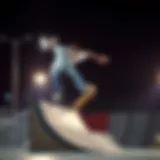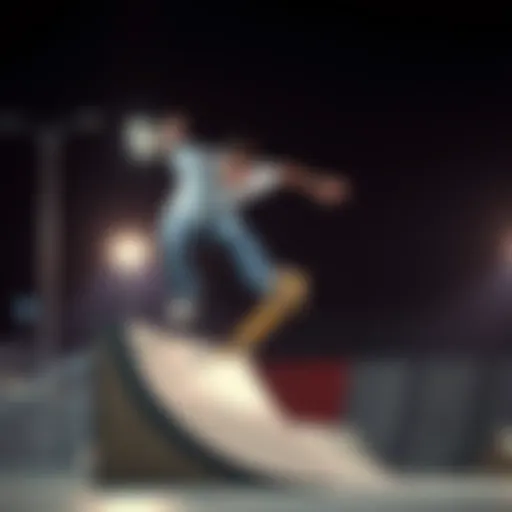Comprehensive Guide to Men's Snowboard Selection
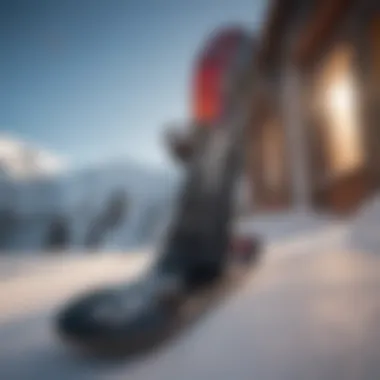

Intro
Snowboarding has transformed from a niche activity into a global phenomenon, capturing the imagination of adventure seekers and extreme sports enthusiasts alike. This guide dives deep into understanding the factors to consider when selecting the perfect men’s snowboard. It sheds light on different board categories, specifications, and what suits different riding styles. Whether you're just starting or have hit the slopes many times, it’s essential to make an informed choice when investing in a snowboard. This piece will walk you through the key components, comparisons, and care tips that can make a helluva difference in your experience.
The History of the Sport
Origin and Evolution
The roots of snowboarding can be traced back to the late 1960s with the invention of the Snurfer, a wooden plank rigged with a rope for steering. Designed by Sherman Poppen in Michigan, this quirky creation combined surfing and skiing in a way that would change winter sports forever. As the years rolled on, enthusiasts tinkered with designs, leading to the development of modern snowboards. It wasn't until the 1980s, though, that snowboarding began to gain recognition on ski slopes, thanks in no small part to pioneers like Jake Burton Carpenter, who pushed for acceptance and innovation in the sport.
Milestones and Influences
The growth of snowboarding can be marked by key milestones, such as snowboarding's inclusion in the Winter Olympics starting in 1998. This legitimized the sport on a global level and spurred interest among youth and amateurs. The cultural shift around snowboarding brought influences from skate and surf culture, establishing a distinct identity that stands apart from skiing. Alongside this evolution came advances in technology, leading to lighter materials and improved designs that enhance both performance and safety.
Key Athletes and Pioneers
Athletes like Shaun White and Travis Rice have played significant roles in popularizing snowboarding. Their exceptional skills and captivating personalities have drawn millions to the sport. White, with his unique tricks and athleticism, expanded the audience. On the other hand, Travis Rice has been influential in pushing boundaries with backcountry riding and filmmaking. These figures have not only inspired countless riders but have also reinforced the importance of progressive techniques and high performance.
Techniques and Skills
Basic Techniques for Beginners
For those new to snowboarding, it’s vital to start with the basics. Learning to balance while sliding down a slope is paramount. A solid stance—keeping your knees bent, shoulders parallel to the board, and arms slightly out—sets the foundation. Start with gentle slopes, practicing turning techniques known as ‘carving’ to control your speed and direction.
Advanced Skills to Acquire
Once comfortable with basics, riders should focus on refining techniques. Skills such as switch riding—where you ride with the opposite foot forward—and jumping can open new avenues in snowboarding. Mastering these will not only boost confidence but also enhance performance during challenging runs.
Common Mistakes and How to Avoid Them
It's easy for beginners to make mistakes, such as leaning too far back or not bending their knees properly. These can lead to falls or injuries. Focus on proper weight distribution; knees should track over your toes. Always look where you want to go! It sounds simple, but many riders get distracted and fall into obstacles.
Safety Measures
Essential Safety Gear
Safety must be a priority for every snowboarder. Essential gear includes:
- Helmet: Always wear one to protect your noggin.
- Wrist Guards: Help prevent injuries during falls, which will inevitably happen.
- Knee Pads and Impact Shorts: Additional protection gives peace of mind, especially for beginners.
Safety Practices and Procedures
Always inspect your equipment before heading out. Be aware of weather conditions and check for avalanche risks if you're planning to ride off-piste. Joining a group or riding with someone experienced can also enhance safety.
How to Prepare for Unexpected Situations
No one wants to think about accidents, but being prepared is smart. Always carry a small first-aid kit and a basic toolkit. Familiarize yourself with ski patrol locations on the mountain and keep emergency numbers handy on your phone or a card in your pocket. A little prep can save a lot of hassle down the line.
Gear Recommendations
Top Brands and Products
When it comes to snowboards, choosing the right brand can make a world of difference. Brands like Burton, Lib Tech, and Rossignol are known for their reliability and performance. Each offers a variety of boards tailored to different skills and styles, ensuring there's something for everyone.
Budget vs. Premium Options
It’s tempting to think cheap boards are just as good, but investing in quality often pays off. Premium boards often last longer and perform better. However, many mid-range boards provide great value for newbies. Do your research, compare specs, and decide what features matter most to you.
Maintenance and Care for Gear
Taking care of your snowboard ensures longevity. Regular waxing keeps it slick, while edge tuning maintains grip. Always dry your board after a day on the slopes to avoid rust. Store it in a cool, dry place, ideally standing up, to keep its shape.
"Snowboarding isn’t just a hobby; it’s a lifestyle. Choose wisely, ride safely, and enjoy every run!"
Understanding Snowboarding
Snowboarding isn't just a sport; it's one of those thrilling pursuits that blends adrenaline with art. Getting to grips with the essence of snowboarding sets the stage for making informed decisions about equipment and riding techniques. In this article, understanding snowboarding lays the groundwork for comprehending how individual elements contribute to the overall snowboarding experience. It opens the door to a broader appreciation of this sport, making it easier to unveil what product fits best for you.
Historical Overview
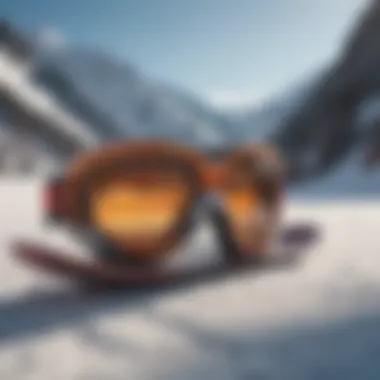

The roots of snowboarding can be traced back to the 1960s when a couple of inventive minds started tinkering with ideas to surf on snow. This initial concept eventually evolved into what we now recognize as snowboarding. Brands like Burton played a pivotal role in refining equipment and promoting this new culture, shaping it into the beloved sport we see today.
In the late 20th century, snowboarding transitioned from an underground movement into mainstream acceptance as ski resorts began to allow snowboarders on their slopes. The sport was given a significant spotlight when it was included in the 1998 Winter Olympics. This not just validated snowboarding as a legitimate sport, but also kicked off a surge in participation and innovation, changing how people view snowy mountain experiences.
Types of Snowboarding
Understanding different types of snowboarding is essential for choosing the right board. Each style caters to various preferences and skills, impacting everything from the type of snowboard to choose, how you ride it, and the overall enjoyment.
- Freeride Snowboarding: Best suited for those who prefer the wild terrain of backcountry areas. Freeriders often crave the untouched powder and unmarked trails, relying on boards designed to handle steep and unpredictable landscapes.
- Freestyle Snowboarding: This style is all about performing tricks and stunts. Freestylers usually prefer a twin-tip board that allows for riding in either direction. If flipping and spinning like in a circus is appealing, this is the path for you.
- All-Mountain Snowboarding: As versatile as a Swiss Army knife, all-mountain boards work well in various conditions and terrains. This option caters to riders who enjoy cruising groomed trails but want the flexibility to venture off-piste occasionally.
- Splitboarding: Particularly popular among backcountry enthusiasts, splitboards can be separated into two skis for uphill travel. They combine the thrill of snowboarding with the challenge of mountain exploration, providing a unique experience entirely.
"Get a suitable board that speaks to your style. This is your journey, after all — do it your way."
Whether you’re a weekend warrior or an extreme sports junkie, understanding the various types of snowboarding not only adds depth to your knowledge but also enhances your experience on the slopes.
Factors to Consider When Choosing a Snowboard
Choosing the right snowboard isn’t just about picking a pretty design or a buddy's recommendation. It’s about pairing your unique style and skills with the right gear. As you stand there at the equipment shop, overwhelmed by choices, knowing what to focus on is key. There are elements that fit into rider experience, riding style, board size, and much more. These aren’t just specifics; they truly affect your performance on the slopes, the fun you will have, and even your safety.
Rider Experience
Your level of experience plays a vital role in the type of snowboard that will suit you. Beginners often benefit from softer flex boards that are forgiving, making it easier to learn without face-planting on every turn. On the other hand, more seasoned riders who enjoy pushing boundaries might prefer stiffer boards, which offer greater responsiveness at high speeds.
Experience is also reflected in the type of tricks you want to try. If you’re more of a pure beginner, you might want to stick with an all-mountain board. But if you're gearing up to master that new jump, you’ll need something designed explicitly for freestyle.
Riding Style
How you ride is gonna have a major say in your selection. Are you the type whose heart races at the thought of shredding powder through the woods? Or are you more inclined to fly off ramps, seeking the thrill of flips and spins? Each of these styles requires a different type of snowboard.
- Freestyle Riders need shorter boards, which provide easier maneuverability for tricks.
- Freeriders, on the other hand, require longer boards for stability and powder handling.
- All-mountain riders should consider versatile boards that perform well in a variety of conditions.
Snowboard Size and Dimensions
Choosing the correct size and dimensions of your snowboard is crucial. A misjudged board can turn what should be an enjoyable ride into a challenging battle.
Length
Length is fundamental as it influences how your board interacts with the snow. A longer board can glide smoothly through powder and is best for high-speed rides, but it can be more difficult to control. In contrast, a shorter board provides agility and a quicker response, making it a popular choice for beginners. If you’re a lightweight rider, aim for a board that reaches between your chin and nose. Conversely, heavier riders generally opt for boards that hit closer to the forehead or above for optimal support.
Width
Width matters a lot, especially for those with bigger feet. A board too narrow will cause toe or heel drag on turns, which can mess up your balance. Wider boards provide a more stable ride and are better suited to larger footed individuals. Ideally, your toes should hang over slightly without compromising your grip.
Effective Edge
Now onto the effective edge — this might not be as talked about but is just as significant. The effective edge directly impacts how well the board will turn. The longer the effective edge, the more grip you'll get on the snow, especially while carving. An effective edge that's too short, however, can lead to less control and stability, especially on steeper slopes. You want something that matches your riding style — longer for stability and shorter for agility.
Flex and Stiffness
Flexibility and stiffness reflect how a board reacts to your movements. A flexible board absorbs shocks better and is ideal for beginner riders or those who like to ride in the park. Stiffer boards, which require more muscle to flex, are typically favored by advanced riders since they can provide the responsiveness needed for high-performance moves. To put it simply, match your flex preference with your riding style and experience level.
Shape and Profile
Understanding board shapes and profiles can be quite enlightening. It’s more than just aesthetics; it influences performance tons.
Camber Types
Camber types define how the board touches the snow at any given time.
- Traditional camber boards are great for edge hold while carving.
- Rocker boards help float better in powder and are great for tricking.
- Flat boards offer a blend of both worlds. Choosing the right camber can impact stability and responsiveness of the board significantly.
Directional vs. Twin Shapes
The shape matters too.
- Directional boards are designed to be ridden predominantly in one direction, suited for those who love exploring downhill runs.
- Twin boards, which are identical in shape and size at both ends, allow for more trick versatility and are better when riding switch.
Identifying which shape caters to your primary riding style can give you an edge on the slopes.
Arming yourself with this knowledge sets you up for picking a snowboard that complements your unique persona on the slopes, making learning smoother and shredding more enjoyable.
Snowboard Categories for Men
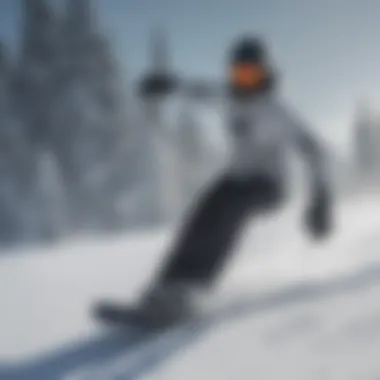

Selecting the right snowboard isn’t just a matter of picking something that looks appealing. The category of the snowboard significantly impacts not just performance, but also how a rider experiences the mountain. Understanding the distinct categories can lead a rider to make an informed decision that aligns with their style and the environments they prefer to tackle. Ultimately, this selection process influences control, stability, and enjoyment on the slopes.
All-Mountain Snowboards
All-mountain snowboards are like the Swiss Army knives of the snowboarding world. They cater to diverse riding styles, making them suitable for those who wish to explore various terrains without being restricted to a single style. Whether you’re gliding down groomed trails, hitting the park, or tackling the backcountry, these boards strike a balance between stability and maneuverability.
- Versatility: Riders can go from carving wide arcs on open slopes to executing tricks in the park seamlessly.
- Flexibility: All-mountain boards often have a medium flex, allowing riders to adapt to changing conditions without feeling overly constrained.
- Recommendations: Ideal for those who are still figuring out what type of riding they’re truly passionate about.
In short, an all-mountain snowboard offers freedom, a bit like a trusty buddy who’s always down for whatever adventure you plan.
Freestyle Snowboards
For those who thrive on jumps, rails, and halfpipes, freestyle snowboards are the ticket to ride. These boards are typically shorter and have a twin-tip shape, allowing for riding in either direction. This characteristic is a boon for tricks and stunts, fueling creativity in the park or on any slope.
- Weight and Length: Freestyle boards are generally lighter and shorter, enabling quick spins and flips. A lighter board feels almost like an extension of your body.
- Stability on Jumps: The design helps absorb impacts from jumps, providing a cushion that minimizes the likelihood of a hard landing.
- Perfect for Tricks: Their construction enables riders to play with their tricks without fear, encouraging growth in skills.
Freestyle boards are a playground for the adventurous, reminiscent of being in a candy store filled with limitless possibilities.
Freeride Snowboards
Freeride snowboards are tailored for off-piste enthusiasts who live for the thrill of untouched powder. As they are designed primarily for performance in backcountry terrains, these boards focus heavily on stability and control at high speeds. Adding one to your gear means you're ready to tackle any wild mountain face thrown your way.
- Stiff Design: The stiffness enhances edge hold on descents, allowing for more decisive turns, especially in variable snow conditions.
- Directional Shape: Many freeride boards feature a directional design, meaning they are optimized for riding forward and provide more effective floatation in powder.
- Ideal Conditions: If you’re the type who scoffs at lift lines, this category is crafted for you.
Freeride snowboards are akin to a rugged 4x4 vehicle; built for adventure, ready to conquer uncharted territories.
Splitboards
For the backcountry-loving snowboarder, splitboards are essential. This unique design splits into two skis for easy climbing, making it possible to access those remote and pristine powder fields without the use of a lift. Once at the top, you reassemble the board for your thrilling descent back to base.
- Climbing Capability: Splitboards are equipped with a special interface allowing skins (traction devices) to adhere for uphill trekking.
- Dual Function: With the push of a few clips, you can go from hiking mode to riding mode, offering versatility that’s unmatched in this gear category.
- Explore beyond Limits: Perfect for those who crave exploration in deep, untouched snow.
Splitboards open the door to a world where the further you go, the better the ride gets, similar to discovering hidden gems in a secret garden.
The choice of snowboard categories ultimately empowers riders to carve their own path. Understanding these options leads to a more enjoyable and fulfilling snowboarding experience.
Analyzing Snowboard Brands
When it comes to selecting the right snowboard, understanding different brands becomes crucial. The snowboard market is sprawling, filled with countless options, but not all brands are created equal. Each company brings its own unique flavor, often cultivated from years of experience, innovation, and rider feedback. This makes analyzing snowboard brands a vibrant topic that lends insightful perspectives to any search for the ideal board.
In this section, we’ll explore the significance of different brands. Not only does this help you see who the major players in the game are, but it also provides insights into their reputations, product pricing, and technological advancements. All of these are key factors that should influence your decision, regardless of whether you're a novice just starting out or a veteran looking to upgrade your gear.
Top Brands Overview
Snowboarding enthusiasts know that choosing a board often comes down to a few top-tier brands that stand the test of time. Companies like Burton, Ride, and K2 dominate the market for a reason. Each brand has carved its niche, offering specific strengths that cater to different boarding styles.
- Burton focuses heavily on innovation, consistently leading in technology and design.
- Ride offers a balance of performance and affordability, popular among all-mountain enthusiasts.
- K2 is known for versatility, providing excellent options across various snowboarding styles.
With these brands, you aren't just buying a snowboard; you're investing in a legacy of knowledge and craftsmanship.
Brand Comparison
Reputation
Reputation in the snowboarding industry can significantly affect market choice. A brand’s reputation is often shaped by rider endorsement and performance over time. Burton, for instance, has a solid reputation built on durability and performance, making it a go-to for serious riders. This brand is well-respected, which is beneficial for those worried about making a poor choice.
Their boards are known to hold up under pressure, meaning fewer trips for repairs and a longer lifespan overall. However, some might say the price reflects their reputation, making it less accessible for budget-conscious riders.
Pricing
Pricing plays its own significant role in brand comparison. Many brands offer a wide range of prices, catering to various budgets and skill levels. For beginners, brands like Salomon or Capita provide affordable yet quality options. Meanwhile, high-performance boards from Lib Tech or Burton can leave a dent in your wallet.
The key is understanding that with higher pricing often comes enhanced technology and materials. This might not matter to a casual rider, but for someone looking to maximize performance, investing a bit more may pay off in the long run. Don't forget to check whether seasonal sales or previous collections are available; this could provide the same quality at a lower price point.
Technology Innovations
When we talk about technology innovations, we dive into what makes one snowboard better than another. Brands like Jones Snowboards are at the forefront, integrating eco-friendly materials with cutting-edge design. Their focus on sustainability is not only appealing but increasingly necessary in today’s market.
Also, features like rockered bases and flex patterns can greatly enhance how a board performs. This allows you to find something that matches your personal style and preferences more accurately. While brands can boast about their tech, it’s wise to read reviews or demo the boards before making any decisions.


Men’s Snowboard Chart
When considering a snowboard purchase, a comprehensive snowboard chart can be a real game changer. It serves as a bridge between riders and their perfect boarding experience, breaking down specifications into bite-sized pieces, making choices easier and more informed. The sizing and performance metrics included in these charts are essential tools for understanding and evaluating equipment.
The correlation between the specific metrics like length, width, and performance attributes such as turn radius and speed ratings make this chart all the more important. Because everyone has different preferences and riding styles, aligning oneself with the right snowboard dimensions helps ensure a tailored experience.
Moreover, with a clear layout, riders can compare boards across various brands, emphasizing critical factors like flex, shape, and the technology used in construction. This can ultimately save money and time, as it helps prevent buyers from making hasty decisions that may result in buyer's remorse.
"Choosing the correct snowboard size and performance metric isn’t just about fit; it’s about your confidence on the slopes."
Sizing Recommendations
Proper sizing is arguably one of the most vital aspects of snowboard selection. A board that fits well enhances maneuverability, improving the overall snowboarding experience. Generally, your height and weight should guide your choices here. If a snowboard is too short, you might find it harder to maintain stability, especially at high speeds. Conversely, opting for a board that's excessively long can make turns cumbersome.
So how does one ride the line? Boards are often designed with size charts, providing a helpful guideline for matching weight classes within different board lengths. For example, a rider under 150 pounds might gravitate toward a board roughly 145 cm long, while those over 200 pounds might need something in the 162 cm range. Riders transitioning from beginner to intermediate may also consider a shorter board for easier handling as they refine their skills.
Performance Metrics
Performance metrics shed light on how a board will perform under various conditions, distinguishing among boards tailored for different styles of riding.
Turn Radius
Turn radius measures how sharply a snowboard can turn. A shorter turn radius means tighter turns, while a longer radius offers smoother arcs. Key in the performance metrics discussion, the turn radius plays a pivotal role in defining a board's responsiveness. Riders seeking agility often prefer boards with a shorter radius, which allows for quick maneuvers in trees or during tricks.
One unique characteristic of turn radius is its impact on speed. Boards that excel in tight turns may not maintain high speeds as effectively in wide arcs. This consideration is essential for riders who enjoy blends of freestyle and free-riding.
Speed Ratings
Speed ratings gauge how fast a snowboard can operate while ensuring stability and performance. Generally, boards that are stiffer can handle better at higher speeds, making them suitable for aggressive downhill riders looking for adrenaline-packed sessions. The speed rating points to a board's responsive nature, especially through choppy terrain.
It’s important to note that a board designed for sheer speed may sacrifice some versatility. A lighter rider, or one focused on freestyle, may prioritize maneuverability over outright speed. Striking a balance between these factors is crucial in achieving an enjoyable ride.
In summary, a men’s snowboard chart not only provides standardized measurements but serves as a detailed roadmap guiding riders through the snowboarding landscape. The significance of proper sizing and performance metrics cannot be overstated, ensuring that each decision made is rooted in a strong understanding of personal needs and riding style.
Care and Maintenance of Snowboards
Maintaining your snowboard is not just about keeping it looking good. It is a vital aspect of ensuring that your board performs at its best, season after season. A well-cared-for snowboard not only maximizes your riding experience but can also save you from costly repairs down the line. Think of it as giving your beloved board the TLC it needs to thrive on the slopes.
Regular Maintenance Tips
Keeping your snowboard in tip-top shape requires some know-how. Below are tips for maintaining your board that you can integrate into your pre and post-snowboarding routine:
- Regular Waxing: Waxing your snowboard enhances its glide and overall speed. A good rule of thumb is to apply wax every 3-5 days of riding. Scraping off the old wax and applying a fresh layer can make a world of difference in performance.
- Edge Sharpening: The edges of your snowboard should be sharp to maintain grip on icy terrain. Inspect them for nicks and burrs after a ride, and sharpen them when necessary using an edge tool. This prevents you from skidding out on those tricky turns.
- Check Bindings: Each time before heading to the slopes, ensure that your bindings are tightened properly. Loose bindings can lead to accidents and less control while riding.
- Clean Regularly: After riding, wipe down your snowboard to remove snow, grit, and moisture. This simple step can prevent rust on the edges and damage to the base.
Taking the time for these maintenance practices can not only extend the life of your snowboard but also enhance your performance on the slopes.
Storage Best Practices
Proper storage of your snowboard during off-seasons can be just as crucial as regular maintenance. Here are some recommended practices for storing your board:
- Dry It Off: Always ensure your board is completely dry before putting it away. Moisture can lead to rust on metal parts and cause the base to deteriorate.
- Store Indoors: Avoid leaving your snowboard in a cold garage or outside. An indoor climate-controlled environment is ideal. Extreme temperatures can warp your board.
- Positioning: Store your snowboard flat rather than leaning against a wall. You don’t want it to get twisted out of shape. Consider using a snowboard bag for protection.
- Avoid Heavy Loads: Don’t stack other heavy items on top of your snowboard. The pressure can warp the board’s shape and impact performance.
"Taking care of your snowboard is not just a chore; it's an investment in your future rides. The better you maintain it, the more enjoyment you’ll extract from every run."
Adhering to these care and maintenance practices ensures that when the first snow falls, your snowboard is ready for action. Whether you're a weekend warrior or a seasoned rider, the effort you put into caring for your gear pays for itself through improved performance and longevity.
Epilogue
Choosing the right snowboard is no small task, but it certainly brings a wealth of joy and experience. This guide has navigated through the intricate world of men’s snowboards, laying out the essential factors to help riders make informed decisions. Understanding individual needs based on riding style, experience, and personal preferences cannot be overstated. The right selection not only enhances performance but also assures safety on the slopes.
Importance of Thoughtful Selection
When it comes to snowboarding, the board is your lifeline; it connects you to the mountain, to the snow, and to the experience. The consequences of an ill-fitting snowboard can lead to mediocre outings at best, or even potential injuries at worst. Therefore, acknowledging the elements that factor into snowboard selection—like size, flexibility, and shape—is vital.
Investing time in research affords riders the benefit of maximizing experiences, whether gliding down powdery slopes or mastering the terrain park. Additionally, knowing how to maintain your board properly prolongs its life, saving money in the long run, and keeping riders on the mountain year after year.
"A good board is like an old friend; strong enough to support you through thick and thin, allowing you to focus on the ride itself."
Social aspects of snowboarding shouldn't be ignored either. The thrill is often compounded by enjoying it with friends and family. Whether it is a weekend getaway or a spontaneous trip, having the right equipment elevates the overall adventure. It encourages exploration and fosters a deeper connection with the sport.
Final Thoughts on Selection
To sum it all up, remember that the journey to find the ideal snowboard can be as exhilarating as the first run on fresh powder. Take the time to analyze your options, try things out, and don’t shy away from seeking advice from more experienced riders. Snowboarding is not merely a hobby; it is a lifestyle that thrives on discovery and the freedom of the slopes.
In this guide, we aimed to provide a multifaceted approach to snowboard selection, encompassing specifications, performance indicators, and maintenance techniques. These crucial elements work hand-in-hand to craft thrilling adventures and unforgettable memories on the snow.
Embrace the thrill, challenge yourself, and invest wisely—after all, the right snowboard is not just a choice; it's the beginning of countless stories waiting to unfold.


